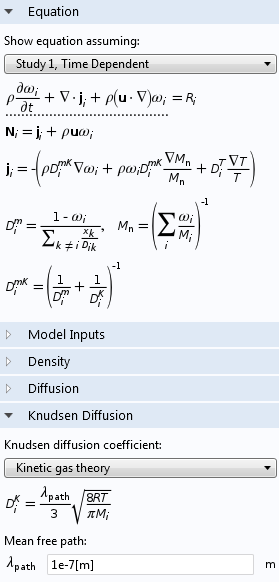
Watch the archived webinar to see COMSOL Multiphysics 5.1 in action. With the help of infinite elements, porous domains are permitted to be unbounded. You can also easily combine porous media and turbulent flow in your fluid flow simulations. In addition, version 5.1 of COMSOL Multiphysics includes a new interface for modeling high Reynolds number dispersed two-phase flow. There is also a new tool for coil geometry analysis, which makes it possible to simulate coils with non-constant cross sections. A new optical material library has been added and includes 1,400 different materials. Updates to mechanical simulations include hygroscopic swelling and nonlinear materials for membranes. If a simulation has an infinite domain, such as for propagation of acoustic, RF, microwave, optical, and elastic waves, you are now able to visualize fields outside of the computational mesh.
#Comsol 5.1 diffusion software#
COMSOL Server, used for managing and distributing apps, allows users to run apps on multiple computers, thus distributing heavy workloads with ease.Īdditionally, this software version introduces a useful Part Library for quick geometry set-up of some common parts. The Application Builder further offers enhanced efficiency through better file handling, searches for strings and keywords, table sorting, and more.
#Comsol 5.1 diffusion license#
Anyone with a COMSOL Multiphysics 5.1 license can open and inspect tutorials and demo apps, even without the add-on products required for specific models. You can now also configure your apps to send simulation reports by email when the results are ready. In COMSOL Multiphysics version 5.1, the Model Builder and Application Builder are more closely integrated, making it easier to turn your models into apps. In this archived webinar, we introduce you to the software and share highlights from the release of version 5.1. In the figure below, the dimensionless position and velocity are plotted as functions of the dimensionless time t‘.COMSOL Multiphysics version 5.1 improves your simulation experience with 20 new demo apps and many new features and functionality enhancements across the product suite.

This plot illustrates that the particle velocity asymptotically approaches the terminal velocity, with most of the acceleration happening during the first few multiples of the Lagrangian time scale τ p. Lithium-air batteries have a theoretical energy density value of about 11400 Wh/kg, which is nearly 10 times greater than, for instance, the lithium-ion batteries used in today's mobile phones and electric cars. The particle position appears to change linearly after this initial acceleration period. Rechargeable metal-air batteries have recently attracted great interest, mainly due to their high specific energy density. Time Scales for Some Typical Particle Sizes Plot of the dimensionless position and velocity of a particle undergoing gravitational settling, starting from rest. To get a better idea of the time scales involved in particle acceleration, suppose the particles are silica glass beads with a density of about 2200 kg/m 3. The following table gives some values for the Lagrangian time scale in air and in water for different particle sizes.

Solving a set of differential equations numerically introduces some amount of error - the difference between the real-world particle motion and the computed numerical solution.


 0 kommentar(er)
0 kommentar(er)
